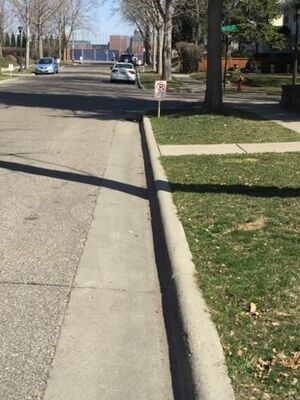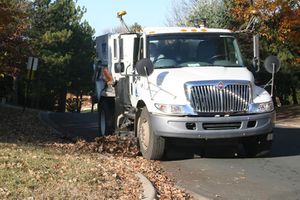
Difference between revisions of "Street sweeping"
m |
m |
||
| (47 intermediate revisions by the same user not shown) | |||
| Line 1: | Line 1: | ||
| − | [[File:Street-sweeping.jpg|300px|thumb|alt=image of street sweeper|<font size=3>Image | + | [[File:Street-sweeping.jpg|300px|thumb|alt=image of street sweeper|<font size=3>Image courtesy Sarah Hobbie, University of Minnesota</font size>]] |
| + | [[File:Clean street.jpg|300px|thumb|alt=clean street image|<font size=3>There are multiple reasons for sweeping streets. However, for water quality purposes, sweeping is best done in spring following fruit drop and autumn following leaf drop. In this image, the street was to be swept the day after the image was taken. Very little water quality benefit will be gained from sweeping this street.</font size>]] | ||
| − | The MPCA | + | {{alert|The MPCA hosted a webinar on street sweeping, Thursday May 13, 9:30-11:00 AM. [[Stormwater Manual webinars|Information from the webinar is posted]] and includes a recording of the webinar, the chat file including answers to questions, and speaker presentations.|alert-info}} |
| − | + | [[Acknowledgements for street sweeping|Acknowledgements]] | |
| − | |||
| − | + | [https://stormwater.pca.state.mn.us/index.php?title=Stormwater_Manual_webinars#May_13.2C_2021_-_Street_Sweeping Street sweeping webinar] | |
| − | |||
| − | |||
| − | |||
| − | |||
| − | + | '''NOTE:'''Hover over bolded text to see the contents for a page | |
| − | *[https://stormwater.pca.state.mn.us/index.php?title= | + | ==Information on street sweeping== |
| − | *[ | + | *[[Overview and benefits of street sweeping]] |
| + | *<span title="This page contains information summarizing recommended sweeping practices, typically to maximize pollutant removal. Information includes when to sweep, recommended equipment, managing sweeping material, cost information, and more."> [https://stormwater.pca.state.mn.us/index.php?title=Recommended_street_sweeping_practices_for_water_quality_purposes '''Recommended street sweeping practices for water quality purposes''']</span> | ||
| + | *Pollutant removal associated with street sweeping | ||
| + | *[[Survey of street sweeping crediting approaches]] | ||
| + | *[[Managing street sweepings]] | ||
| + | *[[Case studies for street sweeping]] | ||
| + | *[[Lessons learned and advice from street sweeping programs]] | ||
| + | *[[Supporting information]] | ||
| − | == | + | ==Street sweeping crediting and Phosphorus Calculator== |
| − | * | + | *[[Street Sweeping Phosphorus Credit Calculator]] |
| − | * | + | *[[Street Sweeping Phosphorus Credit Calculator How-to-Guide]] |
| − | * | + | *[[Street Sweeping Phosphorus Credit Calculator: User Guide]] |
| − | * | + | *[[Methods for sampling street sweeping material - Standard Operating Procedures]] |
| − | * | + | *[[Methods for calculating pollutant reductions (credits) for street sweeping]] |
| − | * | + | *[[Accounting for phosphorus load reductions with street sweeping]] |
| − | * | + | *[[P8 Street Sweeping Modeling]] |
| − | * | + | *[[TSS credits for street sweeping]] |
| + | *[[Guidance for incorporating street sweeping into the Minimal Impact Design Standards Calculator and MPCA’s Simple Estimator]] | ||
| − | == | + | ==University of Minnesota research on street sweeping== |
| − | + | *[https://www.wrc.umn.edu/developing-street-sweeping-credit-stormwater-phosphorus-source-reduction Developing a street sweeping credit for stormwater phosphorus source reduction] - this page contains information and the [https://www.wrc.umn.edu/sites/wrc.umn.edu/files/hobbie_msrc_2018_street_sweeping_credit_final_report_12.10.2020.pdf final report] from the U of M study that led to development of the phosphorus calculator. Researchers: Sarah E. Hobbie, Rachel King, Tessa Belo, Lawrence A. Baker, Jacques C. Finlay. | |
| + | *[http://stormwater.safl.umn.edu/updates-march-2013 Quantifying Nutrient Removal through Targeted Intensive Street Sweeping] - summary of Prior Lake study, 2010-2013 (Kalinosky et al., 2013). For additional information related to this project, [https://larrybakerlab.cfans.umn.edu/research-themes/source-reduction-improve-urban-stormwater-quality link here] | ||
| + | **[https://stormwater.pca.state.mn.us/index.php?title=File:Prior_Lake_Street-Sweeping-Study_final-9-24-2014.pdf Prior Lake study:Estimating Nutrient Removal by Enhanced Street Sweeping] | ||
| − | + | ==Links== | |
| − | + | *Internal | |
| − | + | **[https://stormwater.pca.state.mn.us/index.php?title=File:Street_sweeping_lit_review.docx Final Street Sweeping: Survey of Crediting Approaches] | |
| − | + | **[[Street sweeping for trees]] | |
| − | + | **[[Trees]] | |
| − | + | **[[MS4 fact sheet - Street & Parking Lot Sweeping]] | |
| − | + | *External | |
| + | **[https://www.usgs.gov/centers/umid-water/science/using-leaf-collection-and-street-cleaning-reduce-nutrients-urban?qt-science_center_objects=0#qt-science_center_objects Using leaf collection and street cleaning to reduce nutrients in urban stormwater] - This page summarizes on-going research by the United States Geological Survey on street sweeping. Lead researcher - William Selbig. | ||
| + | **[https://www.chesapeakebay.net/documents/FINAL_APPROVED_Street_and_Storm_Drain_Cleaning_Expert_Panel_Report_--_Complete2.pdf Recommendations of the Expert Panel to Define Removal Rates for Street and Storm Drain Cleaning Practices] - Final document produced by Chesapeake Bay expert panel | ||
| + | **[[Neat websites and articles for trees]] | ||
==Survey of street sweeping practices== | ==Survey of street sweeping practices== | ||
| Line 46: | Line 55: | ||
*Most cities sweep quarterly or less and most do not specifically sweep in response to fall leave drop | *Most cities sweep quarterly or less and most do not specifically sweep in response to fall leave drop | ||
| − | The summary information [https://stormwater.pca.state.mn.us/index.php?title=File:Street_sweeping_survey.pdf can be found here]. | + | The summary information [https://stormwater.pca.state.mn.us/index.php?title=File:Street_sweeping_survey.pdf can be found here]. |
| − | == | + | ==Related pages== |
*[[Trees]] | *[[Trees]] | ||
| + | *[[Phosphorus]] | ||
| + | *[[Total Suspended Solids (TSS) in stormwater]] | ||
*[[Street sweeping for trees]] | *[[Street sweeping for trees]] | ||
*[[Neat websites and articles for trees]] | *[[Neat websites and articles for trees]] | ||
| − | * | + | *[[Guidance for managing sediment and wastes collected by pretreatment practices]]: '''Note''' - this page contains some information on disposal of material collected in pretreatment practices, include information on street sweepings |
Revision as of 23:06, 12 April 2022

There are multiple reasons for sweeping streets. However, for water quality purposes, sweeping is best done in spring following fruit drop and autumn following leaf drop. In this image, the street was to be swept the day after the image was taken. Very little water quality benefit will be gained from sweeping this street.
Information: The MPCA hosted a webinar on street sweeping, Thursday May 13, 9:30-11:00 AM. Information from the webinar is posted and includes a recording of the webinar, the chat file including answers to questions, and speaker presentations.
NOTE:Hover over bolded text to see the contents for a page
Contents
Information on street sweeping
- Overview and benefits of street sweeping
- Recommended street sweeping practices for water quality purposes
- Pollutant removal associated with street sweeping
- Survey of street sweeping crediting approaches
- Managing street sweepings
- Case studies for street sweeping
- Lessons learned and advice from street sweeping programs
- Supporting information
Street sweeping crediting and Phosphorus Calculator
- Street Sweeping Phosphorus Credit Calculator
- Street Sweeping Phosphorus Credit Calculator How-to-Guide
- Street Sweeping Phosphorus Credit Calculator: User Guide
- Methods for sampling street sweeping material - Standard Operating Procedures
- Methods for calculating pollutant reductions (credits) for street sweeping
- Accounting for phosphorus load reductions with street sweeping
- P8 Street Sweeping Modeling
- TSS credits for street sweeping
- Guidance for incorporating street sweeping into the Minimal Impact Design Standards Calculator and MPCA’s Simple Estimator
University of Minnesota research on street sweeping
- Developing a street sweeping credit for stormwater phosphorus source reduction - this page contains information and the final report from the U of M study that led to development of the phosphorus calculator. Researchers: Sarah E. Hobbie, Rachel King, Tessa Belo, Lawrence A. Baker, Jacques C. Finlay.
- Quantifying Nutrient Removal through Targeted Intensive Street Sweeping - summary of Prior Lake study, 2010-2013 (Kalinosky et al., 2013). For additional information related to this project, link here
Links
- Internal
- External
- Using leaf collection and street cleaning to reduce nutrients in urban stormwater - This page summarizes on-going research by the United States Geological Survey on street sweeping. Lead researcher - William Selbig.
- Recommendations of the Expert Panel to Define Removal Rates for Street and Storm Drain Cleaning Practices - Final document produced by Chesapeake Bay expert panel
- Neat websites and articles for trees
Survey of street sweeping practices
The MPCA conducted a survey of cities to determine their street sweeping practices, their interest in a street sweeping credit, and their ability to implement different methods for crediting sweeping. We have not yet fully analyzed the data, but some general conclusions include the following.
- 75 cities responded to the survey and indicated they operate a sweeping program. This was a response rate of close to 50 percent. The responses were distributed geographically across the state and covered a wide range of city sizes (large to small).
- About 78 percent indicated they would be likely to participate in a crediting program
- All but 7 cities can track sweeping information, but 66 percent said they cannot relate material collected to a specific geographic area. This is a question we likely will follow-up with, since being able to relate material to a geographic location is potentially a way of targeting sweeping efforts.
- Most cities estimate volume or mass of material collected, but few measure volume or mass or have the ability to measure dry weight of material collected
- Most cities sweep quarterly or less and most do not specifically sweep in response to fall leave drop
The summary information can be found here.
Related pages
- Trees
- Phosphorus
- Total Suspended Solids (TSS) in stormwater
- Street sweeping for trees
- Neat websites and articles for trees
- Guidance for managing sediment and wastes collected by pretreatment practices: Note - this page contains some information on disposal of material collected in pretreatment practices, include information on street sweepings
